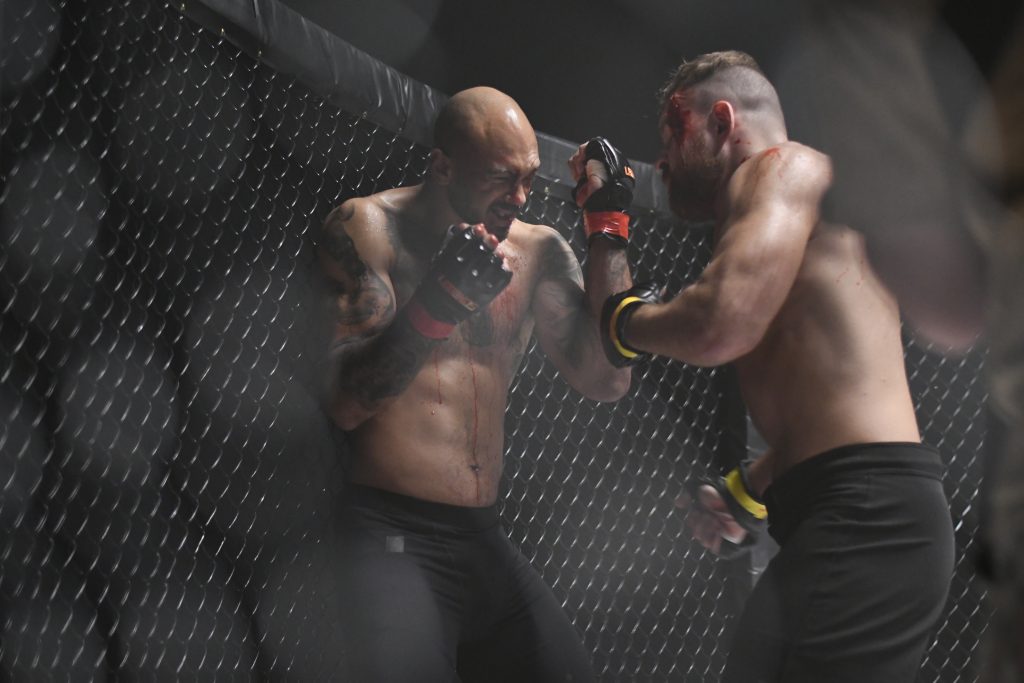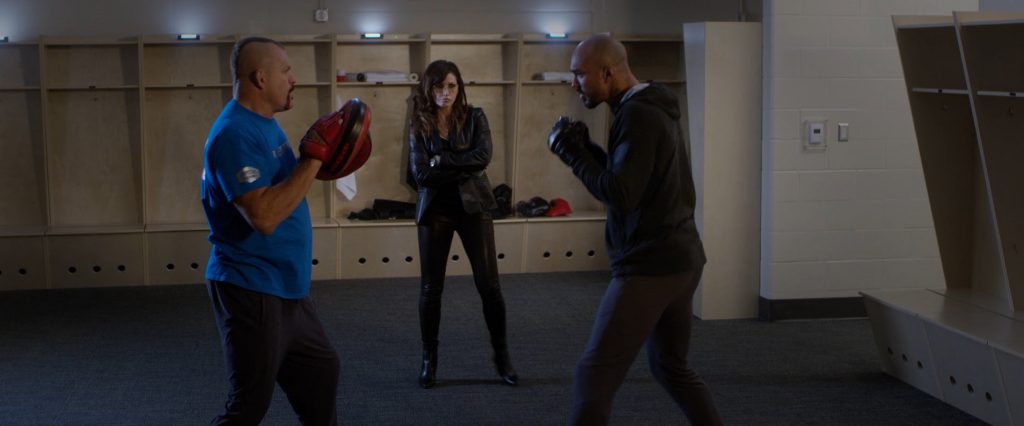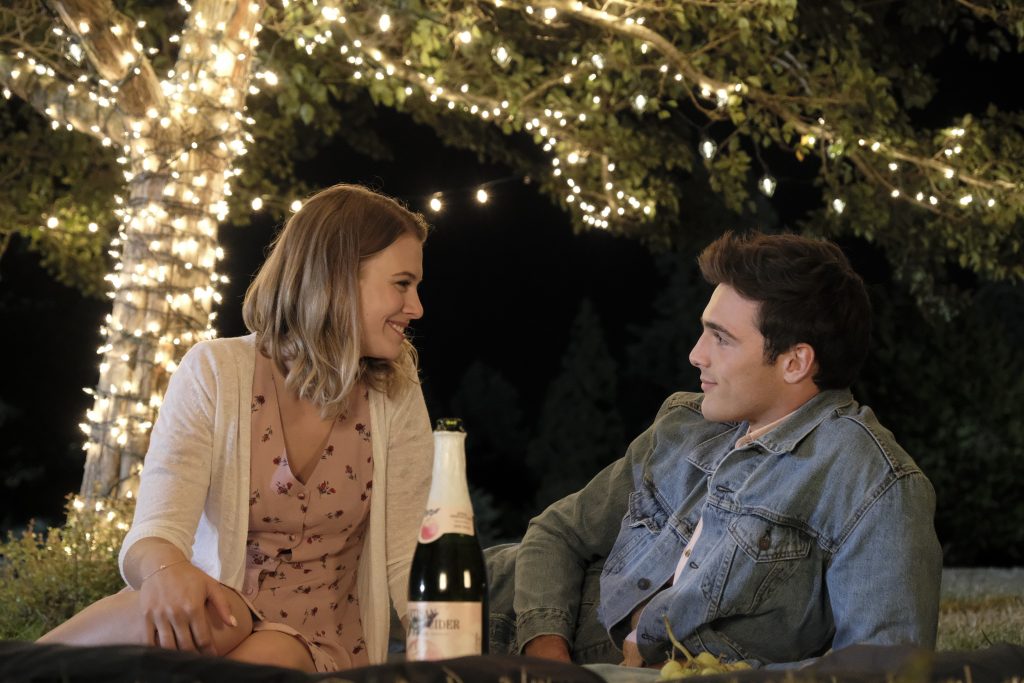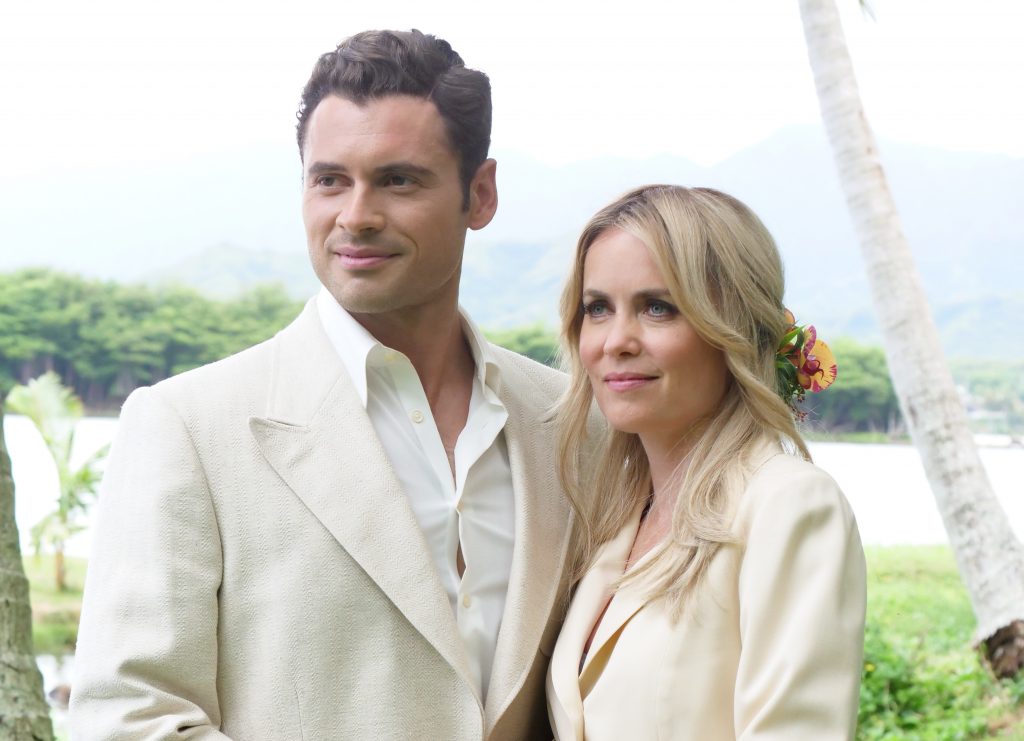December 1 , 2020
by Carla Hay

Directed by Jesse Quinones
Culture Representation: Taking place in London and Los Angeles, the mixed-martial arts (MMA) dramatic film “Cagefighter” features a predominantly white cast (with a few people of color) representing the middle-class and upper-middle-class.
Culture Clash: A world champion in MMA has conflicts with a pro wrestler who wants to break into MMA and become the world champion.
Culture Audience: “Cagefighter” will appeal primarily to fans of the real-life MMA fighters and wrestlers who are in the movie, which has substandard acting and an extremely predictable, badly written story.

If you put the entire cast of “Cagefighter” in an arena filled to the brim with melted cheddar, that still wouldn’t be enough to equal the amount of cheesiness in this so-bad-it’s-almost-funny movie. No one is expecting junk like “Cagefighter” to be high art, but the movie (written and directed by Jesse Quinones) doesn’t even have exciting fight scenes, which is supposed to be the film’s main attraction. Almost everything in “Cagefighter” is formulaic, unimaginative and executed like someone who’s drunk-driving a bulldozer.
At the beginning of “Cagefighter” (which also has the title “Cagefighter: Worlds Collide”) viewers see the movie’s British protagonist Reiss Gibbons (played by Alex Montagnani) win his fifth world lightweight championship title for a mixed-martial arts (MMA) promotion called Legends. It’s a championship belt that he won undefeated. And because of his amazing winning streak, Reiss has become a very famous MMA fighter.
The movie is vague about the origins of Legends. Almost all of the people who work for Legends seem to be American, but for whatever reason, most of this story’s action takes place in London. “Cagefighter” was actually filmed in London, Los Angeles and the Canadian city of Regina.
Montagnani is a real-life professional MMA fighter who goes by the nicknames “The Mean Albatross” or “Mean.” Although he was no doubt cast in this movie for his real-life experience as a professional MMA fighter, it’s clear that the “Cagefighter” filmmakers didn’t care if he had any real acting talent. Montagnani is not the worst actor in the world, but his attempts at being a serious, dramatic actor are more painful to watch than the scenes where Reiss gets beaten up in the ring.
Reiss is supposed to be a “good guy” fighter who does things like give his time to charity and teach underprivileged kids some MMA techniques. He also believes in always treating his fans with respect.
Reiss overcame a troubled background on his path to athletic fame, fortune and championship titles. The oldest of three kids, Reiss and his siblings experienced a tragedy when their parents died when Reiss was 15 years old. After the death of his parents, Reiss had a rough upbringing in a not-so-nice environment.
However, Reiss was taken under the wing of a tough-but-tender MMA trainer/coach named Marcus (played by real-life MMA fighter Chuck Liddell), who helped Reiss become the champ he is today. Reiss says, “Marcus taught me to remain humble, in victory or in defeat.” Reiss has remained loyal to Marcus, who is still Reiss’ trainer/coach. Marcus (who is American) is a strong and mostly silent type, but Liddell still shows a lot of stiff and uncomfortable acting in this film.
As Reiss says in an interview: “If I didn’t have fighting to fall back on, I would’ve been over in a cell or in a box.”(Translation: He would’ve been in jail or dead.) Reiss’ manager and longtime friend Reggie (played by Elijah Baker) also comes from a working-class background. And just like Reiss, Reggie has the thick Cockney accent to prove it.
After winning his fifth Legends world lightweight championship title, Reiss gets flooded with offers from people in the entertainment industry. (The movie lazily depicts this showbiz courting of Reiss by having a montage of different people meeting with him in the same pub and at the same table.) Out of these offers, one of them is a deal to star in a movie, while other deals include endorsements.
Shortly after winning this championship, Reiss is relaxing in his home with his American wife Ellie (played by Georgia Bradner) and Reggie. They’re watching TV when they see an over-the-top blowhard American professional wrestler named Randy Stone (played by Jonathan Good, also known as real-life pro wrestler Jon Moxley), who’s trash-talking Reiss on TV and bragging that he could easily win in a championship MMA fight against Reiss.
Reiss’ immediate reaction is to laugh, since pro wrestling (which is very staged) is a very different type of competition than MMA fighting. MMA fighters are taken seriously as athletes, while pro wrestlers often are not. However, Reggie sees an opportunity to make more money with a crazy idea that wouldn’t work in the real world but is supposed to work in this movie since it’s the basis for the entire plot: Reggie thinks that Reiss should fight Randy for the championship title in Randy’s first professional MMA fight.
Reggie takes his idea to the chief promoter of Legends, a swaggering wheeler dealer named Maxine “Max” Black (played with almost-campy gusto by Gina Gershon), who wears a lot of black leather and thinks she’s always the smartest person in the room. Max cares less about who wins a match and more about how much money and publicity a match will get for Legends. Reggie’s idea is a very hard sell to Max, whose first reaction is to say no.
Max thinks that putting a wrestler in the ring with a well-respected MMA champ will cheapen the sport of MMA and possibly alienate some MMA fans. Reggie pitches the idea to Max by saying that it will be a “win win” for Legends, because Randy has a fan base large enough to fill an arena (the type of large-scale spectacle that Legends would want), while Reiss will probably win over a lot of Randy’s fans, which will help sell tickets to future Legends matches featuring Reiss.
“Think about Conor McGregor when he fought [Floyd] Mayweather,” Reggie pleads to Max. “Do you know how much money that guy is making in endorsements? Millions are coming out of that guy’s ass. And he didn’t even win.”
One thing that Max and Reggie agree on is that Reiss will most certainly win this match against Randy, who doesn’t have a lot of experience in MMA fighting. And so, Max says they can do the match. Reggie then has to convince Reiss, who thinks at first it’s a ridiculous idea, until Reggie says the magic words: “It’s easy money.”
In the lead-up to this championship fight, Randy (who talks as if he’s had too much caffeine or maybe a much stronger stimulant) continues his public insult campaign against Reiss. In media interviews, when people question whether a pro wrestler has what it takes to win a fight against a five-time MMA world champion, Randy arrogantly tells them that he can do it, because he’s in intense MMA training. The non-stop trash talking is what you would expect from a pro wrestler, so Goodman/Moxley doesn’t have to do much acting, but that doesn’t make the “Cagefighter” screenplay less cringeworthy.
During an interview, Randy boasts about himself and continues to degrade Reiss: “I’m in the best shape of my life. I’m stronger than him. I’m bigger than him. I’m tougher than him. I’m better-looking than him. I have no respect for him.” Meanwhile, “nice guy” Reiss sees Randy’s high-octane ego posturing on TV and says, “I want to stick a fork in him, because he’s done.”
There would be no “Cagefighter” movie if Reiss easily beat Randy in this big showdown. Things go wrong for Reiss throughout the movie. And the question becomes if he can make a comeback from all of the setbacks that he experiences. Along the way, Reiss becomes distant from his longtime trainer Marcus and hires a new trainer named Tony Gunn (played by Luke Rockhold), who works with Reiss during a part of the movie when Reiss goes to Los Angeles to train for a big fight.
One of the worst things about “Cagefighter” is how all these extreme, unbelievable things happen in the MMA world during a period of time that’s supposed to be less than nine months. A buffoon pro wrestler like Randy is suddenly able to catapult into the MMA world, and his first professional MMA fight is a world championship title with the reigning champ. And in another part of the movie, Reiss has only three weeks to prepare for a big fight.
How do we know that this story arc happens in less than nine months? Because it’s mentioned in the beginning of the movie, after Reiss won his fifth championship title, that Ellie is pregnant with her and Reiss’ first child together, and the child is born during the movie. However, Ellie never looks pregnant during the months where her pregnancy is supposed to be showing.
And in different parts of the story, there are some really dumb switches in re-classifying Reiss and Randy from lightweight to heavyweight, even though their bodies do not change during the entire movie. The MMA fight scenes are beyond ridiculous, with some heinous and illegal actions during a match (strangling and head-butting) that don’t get any MMA fighter disqualified in this movie. “Cagefighter” is presumably aimed at MMA fans, but the filmmakers don’t have to insult the fans by putting things in the movie that a fan would immediately know are illegal in the sport.
“Cagefighter” also has some almost laughably bad camera shots (parts of the fights in slow motion and melodramatic close-ups of Reiss in agony) and major problems with editing and continuity. After Reiss gets badly pummeled in a fight, his bruises, cuts and other wounds have vanished a few days later. Swollen eyes and deep gashes on Reiss’ body have disappeared faster than you can say, “People should get a refund if they’re unlucky enough to pay money to see this crappy movie.”
The music in “Cagefighter” is a weird mishmash of a score that’s reminiscent of 1970s/1980s TV dramas; modern-ish reggaeton tunes; and generic sports background music. And the production design and cinematography are sloppy, since wide shots of the arena audience look like stock footage, while closer shots of the MMA matches look like the matches are taking place on a movie set instead of a real arena. The shots of Reiss and Randy doing their gauntlet walk into a match are examples of how inauthentic the art direction looks. The fight scenes are actually quite predictable and veer into cartoonish territory, which is what you’re supposed to see in pro wrestling, not in MMA fighting.
As for the shoddily written characters in the movie, Max and Reggie seem to be the only ones who have any semblance of personalities that are somewhat entertaining to watch. Fast-talking Reggie and quick-thinking Max are both hustlers at heart, so their scenes together are the closest thing this movie has to unique liveliness. However, the lines that they have to deliver are so bad that there’s a scene where Baker (who plays Reggie) has trouble keeping a straight face and actually laughs a little when he’s not supposed to be laughing.
The character of Ellie is just another two-dimensional wife in this type of movie. Badly made sports movies like “Cagefighter” only seem to cast the wife/girlfriend/love partner of the male protagonist for the sole purpose of making sure that the protagonist has a pretty woman waiting for him at home or being a spectator during the athletic competitions to show her support.
And as an example of how poorly written the “Cagefighter” screenplay is, Ellie and Reiss never talk about their child. Viewers of this movie might forget that Ellie and Reiss are expectant parents until there’s a brief montage that includes Ellie and Reiss with the baby, who is seen on screen for only a few seconds and then never seen again.
During the end credits for “Cagefighter,” Gershon’s Max character is shown during a heavily edited monologue where she rambles on about different ideas that she has for Reiss and Legends to make more money. It’s obvious that the filmmakers told Gershon to just improvise in character, and she seems to be having lot of fun doing this improv. All this proves to viewers is that you know a movie is terrible when the footage in the end credits is better than almost the entire movie.
Screen Media Films released “Cagefighter” in select U.S. cinemas and on digital and VOD on October 9, 2020. The movie’s release date on Blu-ray and DVD is December 1, 2020.


